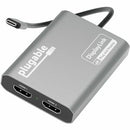Description
Boost your productivity with a two‑screen setup that lets you extend, mirror, or arrange your work across two high‑definition displays. The Plugable USB-C Dual HDMI Adapter (USBC-6950M) is engineered to help you get more out of every work session, especially on Apple MacBooks with M1, M2, or M3 processors that may not natively support multi‑display configurations. By leveraging DisplayLink technology, this compact adapter unlocks immersive dual‑monitor experiences, turning a single USB‑C connection into a robust workstation. Whether you’re coding, designing, analyzing data, or coordinating video meetings, a dual 4K display can dramatically improve focus, context switching, and collaboration—without sacrificing desk space or portability.
- Dual HDMI outputs with up to 4K at 60Hz per display: Expand your desktop to two separate monitors from one USB-C port, delivering sharp 4K visuals for crisp text, vibrant graphics, and fluid video playback. This setup supports HDMI 2.0 standards to maximize color depth and motion, enabling high‑quality presentations, dashboards, and workflows across two screens.
- Designed for Apple Mac M1/M2/M3 and beyond: Perfect for base model Macs that don’t natively support multiple external displays, as well as newer MacBooks and PCs. The adapter works with macOS and Windows systems, providing a seamless bridge to dual‑monitor productivity when native support falls short. It’s ideal for professionals who want to keep reference materials on one screen while drafting on another, or for artists and engineers who benefit from more screen real estate.
- DisplayLink driver required for macOS, Windows, and Linux: To enable reliable dual‑display operation, install the official DisplayLink software. After installation and a quick reboot, your system will recognize the two HDMI outputs and you can arrange monitors in your operating system’s display settings. This driver approach ensures broad compatibility and consistent performance across a range of device configurations.
- Compact, bus‑powered design with robust build quality: The adapter features a slim, durable chassis that fits neatly on your desk or in a bag. It draws power from the USB‑C host connection, so no external power brick is needed for most setups. Its compact form factor makes it an excellent travel companion for remote work, hot desks, or classrooms, while still delivering dependable, stable performance.
- Flexible display modes, broad software compatibility, and reliable performance: Use extended desktop mode to spread apps across two screens, mirror mode for presentations, or picture‑in‑picture workflows where you monitor different content streams simultaneously. With broad OS support, compatibility with popular professional software, and driver‑managed bandwidth sharing, you gain a versatile and future‑proof solution for multi‑monitor productivity.
Technical Details of Plugable USB-C Dual 4K HDMI Adapter
- Host Interface: USB-C (USB 3.2/DisplayLink architecture) for fast data transfer and video signaling
- Video Outputs: 2x HDMI 2.0b ports for dual‑display connections
- Maximum Resolution: Up to 4K at 60Hz per HDMI output (subject to host capabilities, DisplayLink driver, and monitor configuration)
- Chipset: DisplayLink‑based controller (DL‑6950 family or equivalent) enabling multi‑display capabilities via USB
- Power Delivery: Bus‑powered through the USB‑C connection (no external power adapter required in typical setups)
- Operating System Support: macOS, Windows, and Linux with the appropriate DisplayLink driver installed
- Display Modes: Extended desktop, mirrored displays, or individual display configurations via OS settings
- Warranty and Build: Compact aluminum chassis designed for durability and frequent travel
How to install Plugable USB-C Dual 4K HDMI Adapter
- Connect the adapter to an available USB‑C port on your computer. Ensure the USB‑C port supports video output (Display over USB‑C).
- Download and install the recommended DisplayLink drivers for your operating system. Follow the on‑screen prompts to complete the installation, then reboot if prompted.
- After reboot, connect two HDMI cables from the adapter to your two monitors. Power on the displays and ensure they are set to the correct HDMI input sources.
- Open your system display settings (macOS: System Preferences > Displays; Windows: Settings > System > Display). Arrange the monitors to match their physical layout, and set each display to its preferred resolution and scaling.
- Test different configurations (Extended, Mirror, or a combination) to find the setup that best fits your workflow. If you experience any issues, verify that the latest DisplayLink driver is installed and that the monitors’ HDMI cables are rated for 4K at 60Hz.
Frequently asked questions
- Q: Will this work with my MacBook Pro or MacBook Air with M1/M2/M3 chips? A: Yes. The adapter supports Apple Silicon Macs when the proper DisplayLink driver is installed, enabling dual external displays even on machines that don’t natively support two displays.
- Q: Do both displays run at 4K 60Hz? A: In most configurations, each HDMI output can run up to 4K at 60Hz, but actual performance depends on your host computer’s capabilities, macOS/Windows version, DisplayLink driver version, and the monitors’ own specifications. Some scenarios may deliver 4K60 on one display while the other operates at a lower resolution due to bandwidth constraints.
- Q: Do I need an external power supply? A: The adapter is designed to be bus‑powered through the USB‑C connection. Most setups don’t require external power, but if you’re running multiple peripherals or high‑demand displays, using a powered USB‑C hub or a laptop with ample USB‑C power can help maintain peak performance.
- Q: Do I need to install drivers on Windows or Linux as well? A: Yes. For Windows and Linux, DisplayLink drivers are typically required to enable the dual HDMI outputs. After installation and a reboot, you can configure the displays through the OS display manager.
- Q: Are there any known limitations with macOS updates? A: macOS updates sometimes require updated DisplayLink drivers. To ensure smooth operation after an OS update, check for the latest DisplayLink software from the official site and install it before reconnecting the adapters.
Customer reviews
Showing - Of Reviews


